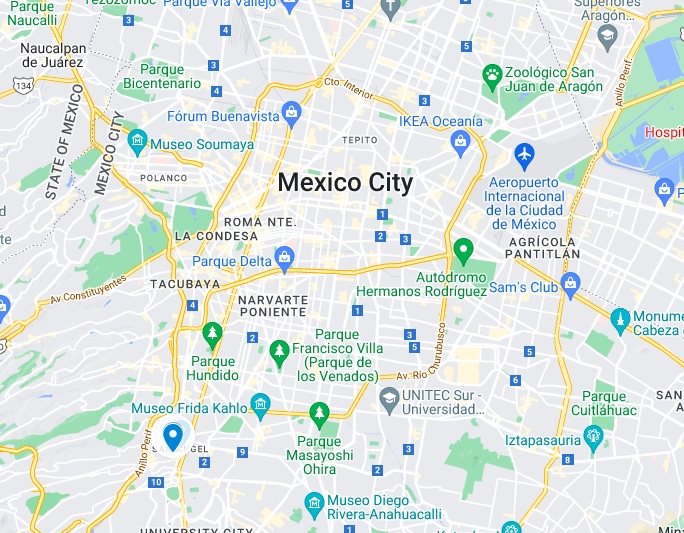Welcome to, in my humble opinion, the most beautiful neighborhood of Mexico City, San Angel. Although Coyoacan also exudes charm by the bucketload, the streets heaving with tourists – and snaking around the corner for the Frida house – stop it from being overly peaceful.
In contrast, San Angel becomes bustling on Saturdays for the mercado but never crowded to the point of being hectic… and during the rest of the week, the crowd-free cobblestone streets are simply idyllic. There are few big-name attractions here which is partly why the barrio stays sleepy and lesser-known.
Despite the lack of tangible attractions San Angel, it’s worth coming. Visiting this charming barrio is akin to stepping back in time. You can almost envisage horses and carts clanking across the cobbles and nobility flowing out of the churches and convents.
Mexico City is a place of contrast in many ways, including the neighborhoods. It’s hard to believe San Angel is in the same city as hectic Centro Historico and polished Polanco. But seeing is believing and I urge you to visit, particularly on Saturdays!

What is San Angel known for?
San Angel is known as a quaint and historic district of Mexico City with religious buildings hailing from the Spanish invasion of Mexico. Today, it’s known for the weekly Bazaar Sabado (Saturday Bazaar) that brings the streets to life with music and wonderful art.
It’s also known for the annual flower fair held for the last 165 years, usually taking place in July. Lastly, San Angel is known for being a safe neighborhood with little to no crime.
Where is San Angel?
How to get to San Angel
By taxi: in an Uber or Didi, you can expect to pay 150-200 pesos from anywhere central. I would advise setting your destination as Plaza del Carmen on the edge of the neighborhood when arriving by road as it’s a good starting point for wandering the area.
By Metro: you can take the underground for just 5 pesos, although the nearest station to San Angel, called Miguel Angel de Quevado, is a 15-minute walk away. It’s on Line 3 which connects to Hidalgo station in Centro or Hospital General station beside Roma Sur.
Metrobus: the Metrobus is cheap (6 pesos a journey) and usually less crowded than the Metro. It travels straight down Insurgentes, allowing you to hop off at La Bombilla station, just 5 minutes on foot to the center. Board it from anywhere along Insurgentes.

History of San Angel
There’s been a settlement here since Aztec times when the city was known as Tenochtitlan and San Angel was called Tenanitla. It was a wealthy area then and it’s a wealthy area now, although it originally attributed its wealth as an agriculture plot.
When the Spanish came and set up monasteries and convents in San Angel, it began to resemble today’s neighborhood. It was after the San Ángel Mártir school (part of Carmen Monatery) that the barrio was named. At this point, it was a separate town but, due to urban growth in the 1940s, Mexico City grew to engulf the barrio – and then some!
In the 18th century, it became a popular place for wealthy locals to have summer homes and this continued into the last century when rich members of society – such as Frida and Diego – had property here.
What to do in San Angel, Mexico City
When you read lists of the must-see attractions in Mexico City, very few will be located here. If you had just a couple of days to explore the capital, this area would probably never make your radar.
For me, that’s all part of the charm! There’s actually a good amount of attractions in San Angel although the first will always top my list…
Saturday Market (Bazaar Sabado)
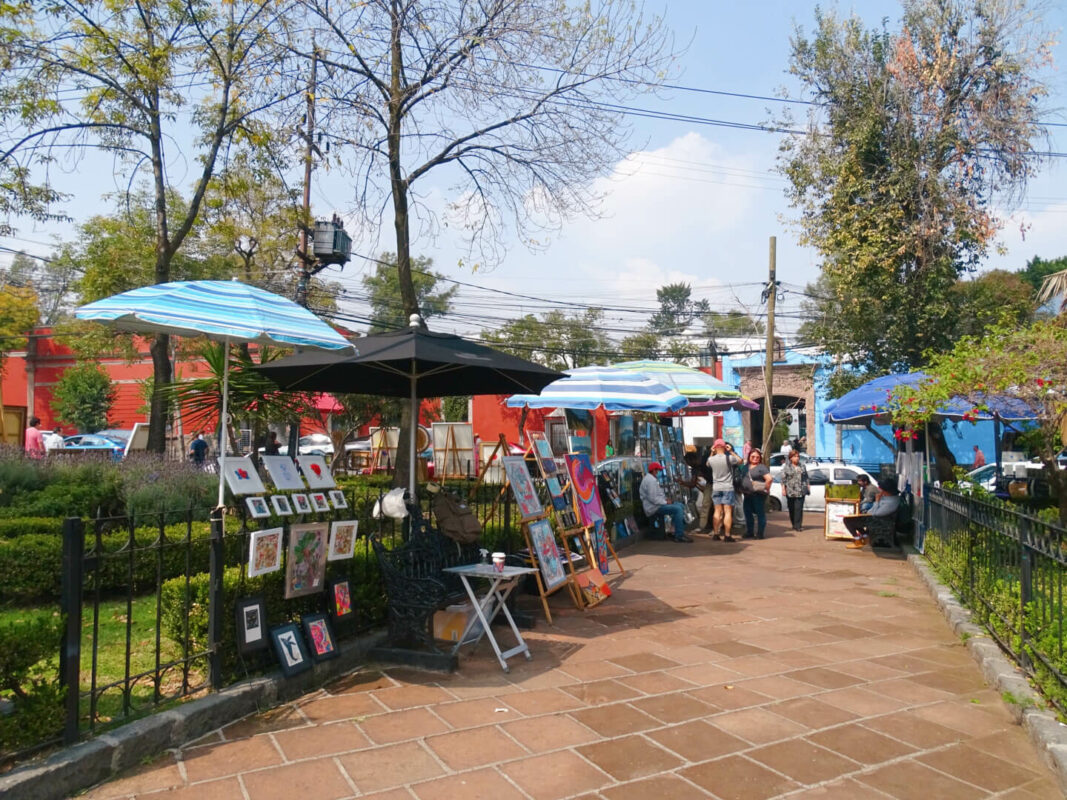
This beautiful market selling art, trinkets, food, and luxe body products was what originally brought me to the neighborhood. Since then, I’ve found more to love about peaceful San Angel… But I still rarely visit between Sunday and Friday!
You can easily spend half a day at the Bazaar Sabado perusing the art stands, snacking on free samples, and listening to live mariachi bands. It’s really worth planning your Mexico City itinerary around.
Read next: guide to visiting San Angel Market in Mexico City on Saturdays
Quick info: 10am-6pm, Saturdays only. Start at Plaza del Carmen then walk along Madero to Plaza Jacinta and the indoor market.
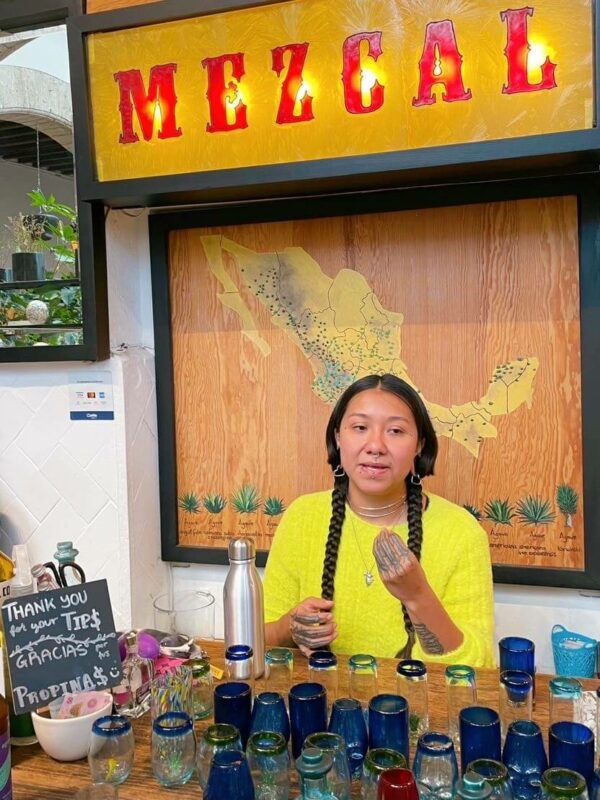
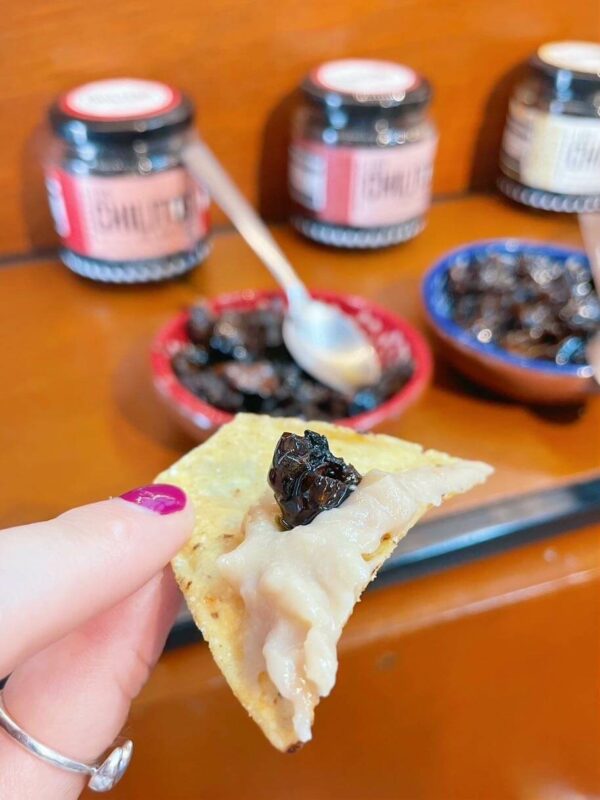
FAQ – are there any market stands Sun-Fri?
Although the art markets in the plazas, the outside tianguis, and the stands in the inside market are closed Sun-Fri, you can still visit San Angel to shop throughout the week. There are plenty of stores on Madero; I’ll share my favorites to come.
Also, it’s still worth checking out the El Bazar Sábado building because it’s absolutely beautiful. This 18th-century hacienda with a huge tree in the middle is home to a popular restaurant, Oxa, where you can go for a sit-down lunch or dinner (just prepare for high prices). There are a couple of shops around the outside selling homeware and jewelry, week-round.


Mercado del Carmen food court

Another place you can visit week-round, not just Saturdays, is this marketplace in a pretty blue colonial building beside Plaza del Carmen. At the front is Cafe Diaz, a good place to stop for coffee. There are some cute stores in the complex like Anthea Tea Boutique which you’ll pass as you head to the food court at the back.
There are lots of options at the food court from sushi to tacos, and it’s one of the more modern (you might even say hipster) places in San Angel. So, if you don’t feel like eating in a historic restaurant, this is the best place to grab lunch, washed down with quality craft beer.
I’ve yet to see the market super busy which is a shame as it seems to have good options.
Plaza Jacinto

The central area of the neighborhood is Plaza San Jacinto (named after San Jacinto Church nearby), an idyllic square with huge decorative water fountains and a cover of shady trees. It’s peaceful in the week and transforms on Saturdays for the market with more art and trinket stands than you can count.
One attraction to find in the square is the easel statue featuring the face of Diego Rivera. He lived not far away in Coyoacan and had his art studio here in the San Angel neighborhood, as I’ll discuss soon.
Parroquia San Jacinto

One of the most beautiful churches in the barrio is San Jacinto Church, just around the corner from Plaza Jacinto. It was founded in the 16th century as a hermitage for Dominican friars, made of red brick and volcanic stone.
Even better might be the peaceful gardens surrounding it. They’re the perfect place for a moment of solace after exploring the bustling plaza, especially if the market’s on.

Two other pretty plazas in the church complex are Plaza de los Arcángeles and Plaza de los Cielos.
Casa del Risco

Beside Plaza Jacinta is one of the gems of San Angel neighborhood, Museo Casa del Risco, a mansion dating back to the 17th century. It’s worth a visit to see the enormous central fountain at its center. This beauty is decorated with ornate pottery and oyster shells.
A particularly atmospheric time to visit is October or early November when it’s dressed up like an ofrenda for Dia de Muertos. Typically in this season, locals decorate ofrendas (altars) in their homes to commemorate loved ones who’ve passed away. Flor de cempasúchil (marigolds) and candles are consistent as well as photos of the deceased and their favorite foods and drinks.


Head upstairs in the cultural center for rooms of historic art and furniture, paying homage to the neighborhood’s aristocratic past.
At weekends, there’s a crafts market in the garden of Museo del Risco.
Entry price: free.
Browse the shops
There’s shopping to be done in San Angel throughout the week with some particularly cute galleries and stores on Madero, a street joining the two plazas, Jacinta and Carmen. A few places I like are:
Templo del Carmen

Templo y Ex-Convent del Carmen is one of the most beautiful places to visit in San Angel neighborhood. Built in the 16th century, this church is full of religious art and some of the oldest tiles in Mexico. From the courtyard, you can spy the ornate tiled domes.
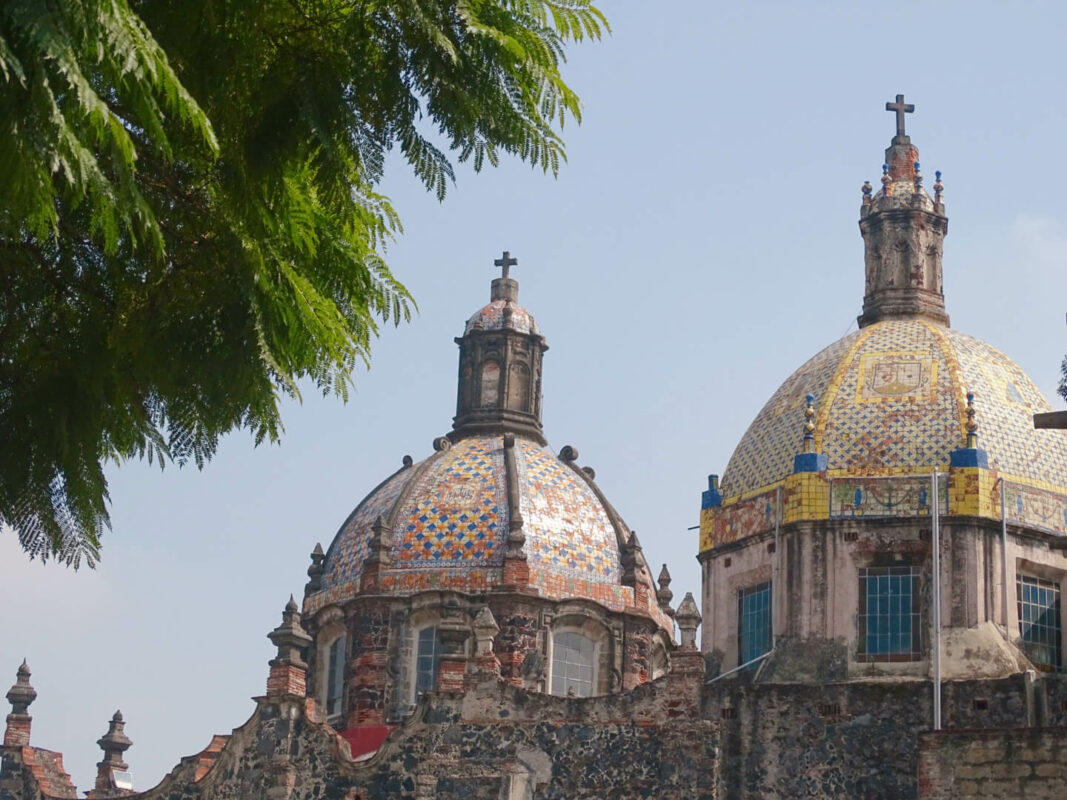
Entry to the church is free and you can spend around 20 minutes looking around. To dig deeper into the convent and its history (and see the oldest residents of San Angel), head next door to…


Museo del Carmen
After visiting Museo del Carmen, I can say the 75 peso entry fee is worth it. Quite frankly, this place is a maze! Calling it a museum is underselling it because, really, the ticket grants you entry to the entire convent including the pretty gardens (once home to 13,000 fruit-picking trees) and the long corridors connecting rooms packed with religious art.

This was one of the largest schools in ‘New Spain’ for the Carmelites, a Catholic brotherhood. However, the convent was abandoned in 1861 due to laws separating the church and state. It then acted as a prison and army barracks before becoming a museum in the 1920s.
Although I’m not a fan of religious art, I enjoyed visiting the charming complex and heading down to the spooky crypt which I’ll mention next. I also found a room at the end of the upstairs corridor dedicated to prehispanic Mexican culture including costumes and dance.
If you visit in October or November, there’s an impressive altar and an informative exhibit about Day of the Dead.
Entry fee: 75 pesos.
English? No, there’s only Spanish signage apart from in the prehispanic culture museum which is in both languages.
Opening times: 10am-5pm, Tues-Sun. Like most Mexico City museums, it’s closed on Mondays.
Crypt (and mummies!) at Carmo Convent

The 75 peso entry fee includes entry to the spooky crypt, home to the intriguing Mummies of San Angel.
It’s said that the Carmelites rented out space in their crypt for bodies to be stored; the bones would later be taken to an ossuary. But when the church and state were separated and the convents forced to shut, the Carmelites took off, leaving the crypt sealed.
Later, revolutionary Zapatista groups searching for treasure came across the crypt and found the bodies had been naturally mummified (due to the unique soil profile and the volcanic rock the convent was built with).
Although a priest pushed to bury them, the San Angel locals thought them too unusual. So, instead, the mummies were put on display in glass and velvet caskets, and subsequently became the stuff of legends and spooky stories, even inspiring several movies.
Museo Casa Estudio Diego y Frida
Art fans will think one of the best things to do in San Angel is visit Museo Casa Estudio Diego Rivera y Frida Kahlo – not to be confused with the Frida Kahlo Museum over in Coyoacan (which is the better place to see her art: there’s more here belonging to Diego).
Here you can see three artistic houses: a red and white one for Diego, a bright blue one for Frida, and one for their architect and artist friend, Juan O’Gorman (who designed the whole residence as well as parts of the nearby UNAM campus). Some will say that Diego and Frida’s houses being separated but connected by a bridge symbolizes their rocky yet eternal relationship.
Walk through the houses to see their studios and spy a striking view from the rooftop. Choose to pay extra for a tour guide if you want to learn more about history and art.
Entry fee: 45 pesos.
English signs? No.
Opening times: 10am-5.30pm; closed Mondays.
Parque de la Bombilla & Monumento Alvaro Obregon


San Angel isn’t the most hectic neighborhood in the world (let’s face it, Mexico City has several contenders) but if you want to escape the hustle and bustle, there’s a park just a few minutes from the center.
Parque de la Bombilla is a pleasant place for a walk with water fountains and a huge memorial to ex-president (1920-24), Alvaro Obregon, one of the four key players in the Mexican revolution and the last to be assassinated.
He was killed in 1928 while dining at a restaurant named La Bombilla that used to stand on this spot. For a while, the monument hosted his embalmed arm that he’d previously lost in battle. Gulp!
The park has a pleasant, family-friendly vibe with a kid’s play area and, when I visited, lots of colorful art sculptures being built by young girls.
Museo Soumaya Plaza Loreto
Museo Soumaya Plaza Loreto is the lesser-famous of the two Soumaya museums in CDMX (the better-known one is in Polanco) but it’s actually the original of the two art collections belonging to the richest man in Mexico, Carlos Slim. With a Eurocentric focus, you’ll see impressive art and sculptures from artists including Salvador Dali.
Entry is free and there are cultural activities held daily. The museum is a 10-minute drive/Uber ride from the center or you can jump on a bus. Two hours is enough time to see everything inside.
San Angel Flower Market

The Flower Market doesn’t take long to visit, making it a quick and easy thing to do in the San Angel neighborhood. It’s just one row of flower stands along Avenue Revolución, beginning at the impressive mural below.

This flower market has been open for centuries dating back to days when friars at the monastery would buy flowers here. To see the mural and beautiful array of flowers, it’s worth swinging by.
Where to eat in San Angel CDMX

This isn’t a neighborhood where you’ll find modern eateries and international chain restaurants. Instead, there are historic Mexican establishments that have been open for decades. Many have hosted past residents like Frida, Diego, and Mexican presidents. Some are pretty pricey, but worth a visit I’d say.
One newer yet just as atmospheric restaurant for traditional dishes is…
Na Tlali

Na Tlali is one of my all-time favorite restaurants in Mexico City serving vegan versions of classic Mexican dishes from Oaxaca and Vera Cruz.
The breakfast menu is fantastic with seven types of chilaquiles with rich, delicious sauces as well as enchiladas and pancakes. The lunch and dinner dishes are just as tasty; I’d know because I’ve eaten most of them!
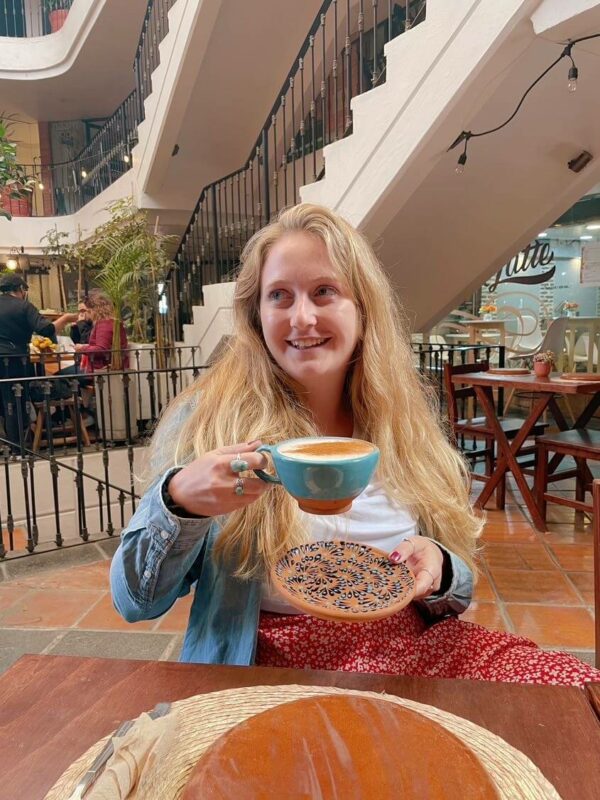

The coffee isn’t the strongest in my opinion but the hot chocolate made with either water or (plant) milk is fantastic. They do great aguas del dia with ever-changing flavors. You can expect to pay around 250 pesos for a main dish and drink, plus tip.
The restaurant is never too busy (although it deserves to be!); I’ve never needed a ressy.
San Angel Inn
The famous San Angel Inn of Mexico City is somewhere you come for an idyllic dining experience. Stepping through the door is stepping back in time to a world where waiters dress in black and white and the whole restaurant is preserved like a living museum with historic artwork on the walls, blue and white ceramics, and ornate doorways and chandeliers.
The Inn started life as Santa Ana Monastery, a beloved building surrounded by orchards. It was then purchased in 1777 by Ramon Goicoechea and used as a residential mansion until 1902 when it became a hotel and restaurant. Prices are high and the food isn’t the best; it’s really the experience you visit for.
Although the interior is undeniably grand, the best place to dine is outside in the courtyard beside the decorative fountain. I urge you to book ahead because it’s understandably popular.
El Cardenal
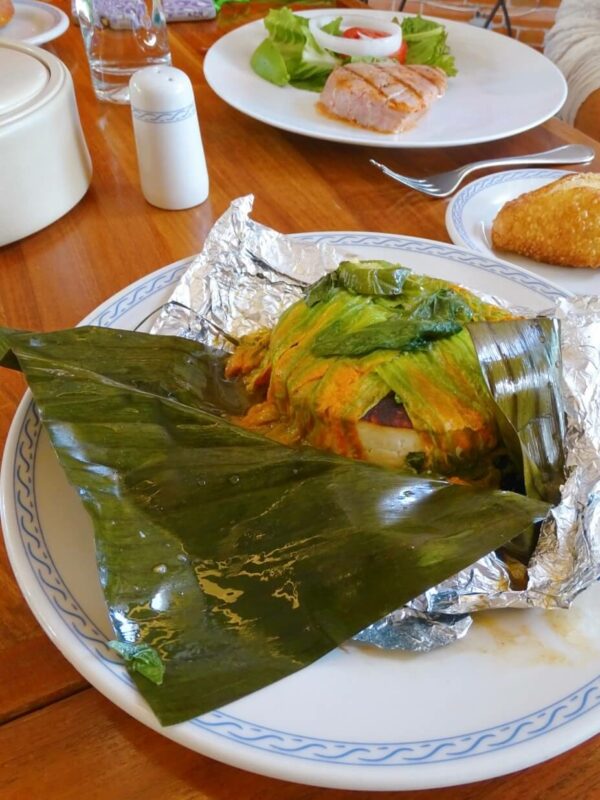

This is a historic venue on Avenue de la Paz (‘the Peace’), a street christened by ex-president Porfirio Díaz. Although this colonial mansion – complete with stained glass windows – has been around for decades, the restaurant opened in 2011, making it the fourth of the El Cardenal franchise in the city.
It’s somewhere with a vibey atmosphere where you’ll see groups of Mexican families enjoying high-end classic Mexican food with a focus on meat and fish. Veggies will survive but it’s certainly not a plant-based dream. Mariachi bands play at your table if you request, and there’s a glass kitchen window where you can see the chefs at work.
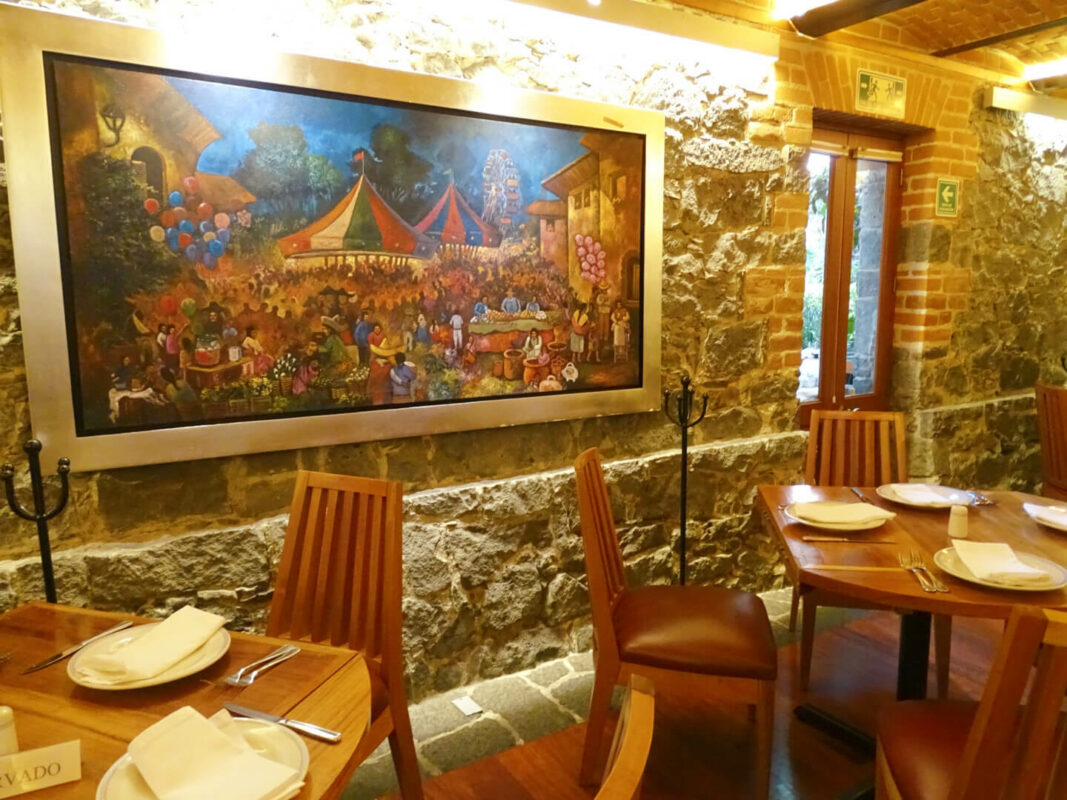
The food was tasty (and most people will agree better than San Angel Inn) but I have to say my favorite thing was the fresh bread. It was so soft and smelt amazing! Also, you can’t beat the hot chocolate.
El Cardenal is open from 8am-6.30pm daily so visit for breakfast through ’til late lunch. Main dishes typically cost 300-400 pesos which isn’t too bad considering the classy dining experience.
Other places near San Angel, Mexico City
Down in the south of the city, you may choose to tag on a few other Mexico City neighborhoods into the same-day excursion. I recommend…
Coyoacan
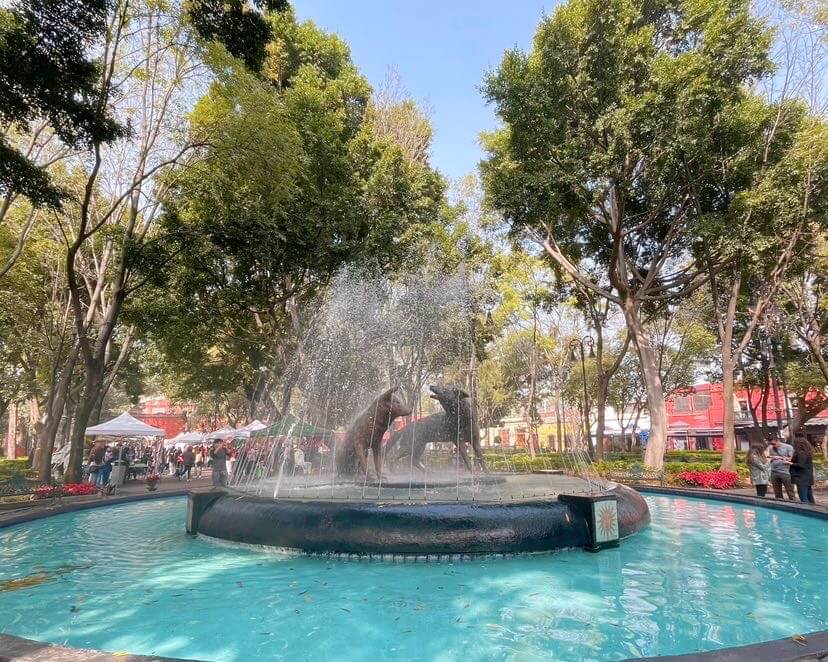
If you’re in the know about lesser-known neighborhoods like San Angel then I’m sure popular Coyoacan is already on your radar. The drive between the two should take 15 minutes and cost 50-80 pesos in an Uber (unless it’s peak time when prices surge), or you can walk to Avenue Revolucion to catch a bus.
Frida Kahlo’s old home, Casa Azul, is the top attraction (make sure to book your ticket a few days ahead) but there are several other things to do in Coyoacan like visiting Mercado de Coyoacan to find the famous tostadas standard and wandering vibey Plaza Hidalgo.
The Museum of Popular Culture is a funky, colorful place with just 20 pesos entry, while the Leon Trotsky Museum is a good spot for those interested in 20th-century Mexico.
There are some quality Mexico City coffee shops here; visit Cafe Avellaneda for the best specialty coffee, Cafe Negro to sit down with proper coffee (Avellaneda barely has room to stand!) or co-work, and El Jarocho for a historic neighborhood fave (takeout only).
Half a day is a good amount of time to spend in Coyoacan so you could certainly fit San Angel and Coyoacan into the same day.
UNAM (University City)
Visiting a university as a tourist attraction? Stay with me here. UNAM is a vast complex with treasures onsite like the Botanic Gardens, museums, and galleries. I particularly like the Museum of Contemporary Art. Don’t miss the Central Library painted with 4,000m of murals by Juan O’Gorman.
You could spend anywhere from a couple of hours to a whole day here!
Xochimilco

The vast waterways of southern Mexico City make for a great day out.
The majority of tourists visit to ride the colorful trajineras which is a fun experience. You can hire a mariachi band to play on your boat and eat from floating food vendors (but I only recommend the snacks and drinks – for proper food, eat at the restaurants on the banks because food from the floating vendors is expensive and has given several of my friends food poisoning).
Magical port is the busiest so on weekends I prefer to go from the quieter Embarcadero Cuemanco instead. A boat costs 600 pesos per hour so I advise getting a group together.
If crowded party boats aren’t for you, take an eco-tour around the quiet sections of the waterways with Pachoa Mexico to learn about how the islands are used for agriculture, or try a sunrise kayaking excursion. I can personally vouch for both these things.
How to plan a trip to the south of Mexico City? Since you have 4 places (San Angel, Coyoacan, UNAM, and Xochimilco), do 2 per day. If you just have one day allotted, pick the 2 that most appeal to you.
Thanks for reading!
More Mexico City neighborhood guides:
- Things to do in Centro Historico, Mexico City
- Roma Norte and Roma Sur neighborhood guide
- Juarez, Mexico City area guide
More Mexico City blogs:
- Best breakfast and brunch in Mexico
- My favorite bars in CDMX
- The best cafes in Mexico City
- Vegan restaurants in Mexico City
- Cutest cafes in La Condesa
More Mexico City blogs:

